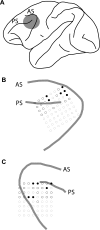Cholinergic modulation of working memory activity in primate prefrontal cortex
- PMID: 21795623
- PMCID: PMC3214100
- DOI: 10.1152/jn.00148.2011
Cholinergic modulation of working memory activity in primate prefrontal cortex
Abstract
The prefrontal cortex, a cortical area essential for working memory and higher cognitive functions, is modulated by a number of neurotransmitter systems, including acetylcholine; however, the impact of cholinergic transmission on prefrontal activity is not well understood. We relied on systemic administration of a muscarinic receptor antagonist, scopolamine, to investigate the role of acetylcholine on primate prefrontal neuronal activity during execution of working memory tasks and recorded neuronal activity with chronic electrode arrays and single electrodes. Our results indicated a dose-dependent decrease in behavioral performance after scopolamine administration in all the working memory tasks we tested. The effect could not be accounted for by deficits in visual processing, eye movement responses, or attention, because the animals performed a visually guided saccade task virtually error free, and errors to distracting stimuli were not increased. Performance degradation under scopolamine was accompanied by decreased firing rate of the same cortical sites during the delay period of the task and decreased selectivity for the spatial location of the stimuli. These results demonstrate that muscarinic blockade impairs performance in working memory tasks and prefrontal activity mediating working memory.
Figures






Similar articles
-
Muscarinic Attenuation of Mnemonic Rule Representation in Macaque Dorsolateral Prefrontal Cortex during a Pro- and Anti-Saccade Task.J Neurosci. 2015 Dec 9;35(49):16064-76. doi: 10.1523/JNEUROSCI.2454-15.2015. J Neurosci. 2015. PMID: 26658860 Free PMC article.
-
Matching patterns of activity in primate prefrontal area 8a and parietal area 7ip neurons during a spatial working memory task.J Neurophysiol. 1998 Jun;79(6):2919-40. doi: 10.1152/jn.1998.79.6.2919. J Neurophysiol. 1998. PMID: 9636098
-
Cholinergic blockade under working memory demands encountered by increased rehearsal strategies: evidence from fMRI in healthy subjects.Eur Arch Psychiatry Clin Neurosci. 2012 Jun;262(4):329-39. doi: 10.1007/s00406-011-0267-6. Epub 2011 Oct 18. Eur Arch Psychiatry Clin Neurosci. 2012. PMID: 22006639 Clinical Trial.
-
Prefrontal cortex and working memory processes.Neuroscience. 2006 Apr 28;139(1):251-61. doi: 10.1016/j.neuroscience.2005.07.003. Epub 2005 Dec 1. Neuroscience. 2006. PMID: 16325345 Review.
-
Behavioral pharmacology and biochemistry of central cholinergic neurotransmission.Adv Exp Med Biol. 1991;295:399-414. doi: 10.1007/978-1-4757-0145-6_23. Adv Exp Med Biol. 1991. PMID: 1663698 Review.
Cited by
-
The anterior cingulate cortex may enhance inhibition of lateral prefrontal cortex via m2 cholinergic receptors at dual synaptic sites.J Neurosci. 2012 Oct 31;32(44):15611-25. doi: 10.1523/JNEUROSCI.2339-12.2012. J Neurosci. 2012. PMID: 23115196 Free PMC article.
-
Spatial diversity of spontaneous activity in the cortex.Front Neural Circuits. 2015 Sep 24;9:48. doi: 10.3389/fncir.2015.00048. eCollection 2015. Front Neural Circuits. 2015. PMID: 26441547 Free PMC article. Review.
-
Spike Afterhyperpolarizations Govern Persistent Firing Dynamics in Rat Neocortical and Hippocampal Pyramidal Cells.J Neurosci. 2022 Oct 12;42(41):7690-7706. doi: 10.1523/JNEUROSCI.0570-22.2022. Epub 2022 Sep 6. J Neurosci. 2022. PMID: 36414011 Free PMC article.
-
Effects of cholinesterase inhibition on attention and working memory in Lewy body dementias.Brain Commun. 2023 Jul 27;5(4):fcad207. doi: 10.1093/braincomms/fcad207. eCollection 2023. Brain Commun. 2023. PMID: 37545547 Free PMC article.
-
Neuromodulation of Persistent Activity and Working Memory Circuitry in Primate Prefrontal Cortex by Muscarinic Receptors.Front Neural Circuits. 2021 Mar 15;15:648624. doi: 10.3389/fncir.2021.648624. eCollection 2021. Front Neural Circuits. 2021. PMID: 33790746 Free PMC article. Review.
References
-
- Arnsten AF, Li BM. Neurobiology of executive functions: catecholamine influences on prefrontal cortical functions. Biol Psychiatry 57: 1377–1384, 2005 - PubMed
-
- Barraclough DJ, Conroy ML, Lee D. Prefrontal cortex and decision making in a mixed-strategy game. Nat Neurosci 7: 404–410, 2004 - PubMed
-
- Bartus RT, Johnson HR. Short-term memory in the rhesus monkey: disruption from the anti-cholinergic scopolamine. Pharmacol Biochem Behav 5: 39–46, 1976 - PubMed
-
- Bartus RT, Dean RL, 3rd, Beer B, Lippa AS. The cholinergic hypothesis of geriatric memory dysfunction. Science 217: 408–414, 1982 - PubMed
Publication types
MeSH terms
Substances
Grants and funding
LinkOut - more resources
Full Text Sources

